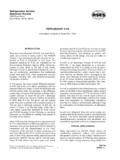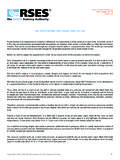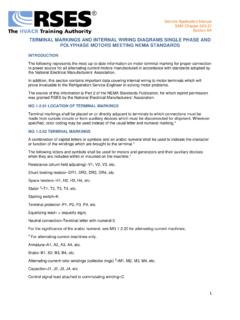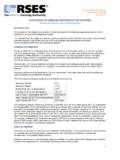Transcription of REFRIGERANT PIPING INTRODUCTION - RSES.org
1 Copyright 1964, 2009, By refrigeration Service Engineers Application ManualSAM Chapter 630-33 Section 1 MREFRIGERANT PIPINGBy: Cecil R. Visger, Past International PIPING INTRODUCTIONIn recent years, manufacturers of condensing units have more and more gone to motor-compressor units and direct-drive compressors, which means that the compressors are turning at motor speeds. These relatively high-speed compressors cannot operate without proper lubrication at all times. Even more than formerly, adequate oil return must be PIPING is conducive to long life and minimum repairs to the equipment, such as reduction of damage to compressors by broken valves, burned out bearings and scored cylinders by the lack of proper oil return; and damage to expansion valves due to wire drawing as a result of flash gases, to name only a few of the possible damages.
2 After all, it is to the best interest of all to make the customer s equipment operate as efficiently and economically as chief purpose of this discussion on REFRIGERANT PIPING is to point out some of the precautions to be taken which affect the life and efficiency of refrigerating equipment, and to offer some helpful suggestions in PIPING design, selection and author knows of nothing the user appreciates more, and which causes him to feel that he has received his money s worth, than NEATNESS. That is something he can see and understand.
3 The only way fittings will fit properly is to install the PIPING runs plumb and level, except when otherwise necessary to pitch for proper drainage. The supporting of pipes is part of the job of neatness, and should be done as part of the permanent results as intended in the original engineered layout. The intervals or spacing of the supports will be governed by the type and size of pipe, but should be close enough to avoid any sagging between the order to be able to properly select the valves, fittings and pipe for an installation, and the connection of the equipment for a given job, the location of each piece of the equipment with relation to each other component must be determined.
4 These locations decide the design of the PIPING as well as the size and length, and they also determine the necessary valves and fittings. The first thing to do then is to make a layout. For small installations, the layout may even be mental; but there should be a thought-out plan before erection is simplify our discussion we shall divide it into four sub-topics, namely:DISCHARGE OR HOT GAS LINESLIQUID LINESSUCTION LINES FOR R-12 SIZING REFRIGERANT 1964, 2009, By refrigeration Service Engineers OR HOT GAS LINESThe discharge or hot gas PIPING is as important as the other two lines.
5 In many installations remote condensers are used, such as remote air-cooled condensers and evaporative condensers. Installations of these types present their problems, and should be piped to avoid excessive vibration, provide against the entrainment of oil, and for traps where necessary to protect the usual recommended maximum pressure drop for calculations of R-12 hot gas lines is 2 psig, and a minimum velocity of 1,500 fpm (feet per minute) in vertical, and 750 fpm in horizontal PIPING to maintain oil movement.
6 These results can be obtained by referring to the manufacturers charts on pipe sizing .Care should be taken when connecting condensing units in parallel, and each with its own receiver. The hot gas lines should be arranged so that the equalizer pipe between them is as short and as near the receivers as possible. (See Figure 66F01.) This equalizer should be at least the next size smaller pipe than the discharge PIPING . When connecting two or more compressors to one condenser, it is best to run a discharge line for each compressor directly into the condenser.
7 If this method is not practical, each compressor discharge line should be connected to the main hot gas line in a Y or offset T , as in Figure 66F02A and Figure 66F02B, but never bull-headed, as in Figure 66F01 Paralleling Condensing UnitsFigure 66F02A Y connection for paralleling the hot gas lines from two compressors to a condenser at a lower level (right).Figure 66F02B T or offset connection for paralleling the hot gas lines from two compressors to a condenser at a lower level (right).Copyright 1964, 2009, By refrigeration Service Engineers 66F02C Bullhead (Wrong) and two permissible connections for paralleling two hot gas opposing flow of REFRIGERANT gases, as shown in the left diagram in Figure 66F02C, can set up a turbulence that may cause pulsation in the PIPING .
8 If the rise to the main hot gas line is over 4 or 5 ft, the branch lines should connect to the main line above the center of the main line PIPING . Another suggested method for hot gas lines, when paralleling two compressors, is shown in Figure 66F03A. Another method of equalizing hot gas and receiver pressures and crankcase the condenser is as much as 8 or 10 ft above the compressor, provisions should be made to trap the oil and REFRIGERANT that might otherwise condense in the compressor heads when the compressors are stopped.
9 (See Figure 66F03B and Figure 66F03C.) Using this method, oil and REFRIGERANT will soon return to the system when the machine starts again, without damage to valve plates or heads. For each additional 30 ft rise, another trap should be provided, dividing the amount of pipe proportionately to each trap. These traps should be made as short as fittings will 1964, 2009, By refrigeration Service Engineers Figure 66F03C Separate hot gas lines from compressors to one condenser at a higher level, showing traps to prevent oil, and REFRIGERANT from running back down into the compressor heads when the compressors 66F03C Similar connections to those in Figure 66F03B, except one hot gas line is used for both compressors.
10 Note use of Y connections and it is anticipated that the compressor temperature may be lower than the receiver temperature, and that the receiver is located above the compressor, a check valve should be installed in the discharge PIPING near the receiver (Figure 66F03D). This will prevent REFRIGERANT evaporated out of the receiver from condensing in the compressor head, and causing serious damage when the compressor 66F03 DUse of check valve in hot gas line with condenser above the compressor if compressor is in cooler location than CONDENSER DISCHARGE LINEST oday we are becoming concerned with water-saving devices, and one of these is the evaporative condenser.








